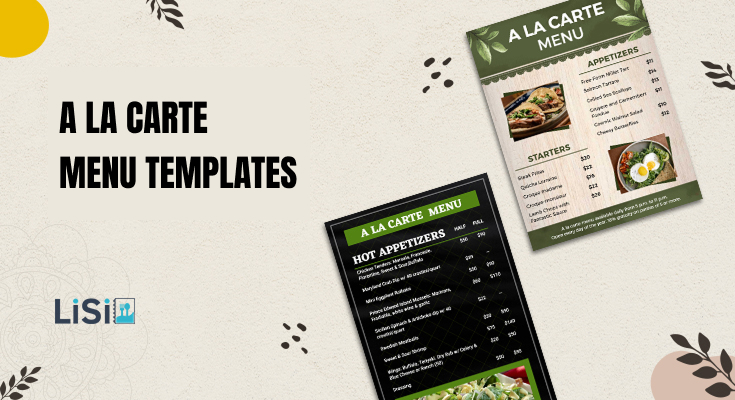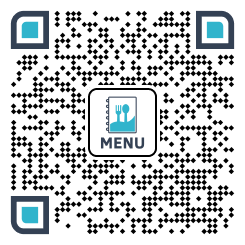Explore a la carte menu templates to create a perfect menu that offers more flexibility and boosts customer satisfaction with your restaurant’s offerings. A la carte dining style allows guests to order individual dishes instead of fixed meal combos, giving them full control over what they eat and how much they spend.
In this guide, you’ll learn how to create a smart, effective a la carte menu with templates that enhance the dining experience and support your business goals.
What is the Meaning of A La Carte Menu Template?
An a la carte menu template is a customizable design layout used to present individual food items, each with its own price, rather than grouped meals or combos. “À la carte” is a French term that means “according to the card,” referring to ordering items separately instead of as part of a fixed menu. This type of menu gives diners the freedom to pick exactly what they want—perfect for restaurants, bistros, cafes, or fine dining settings.
For example, you can order just a salad, or just a main dish, or even only dessert if you like. This type of menu gives you more choice and control over what you eat and how much you spend. And the other menu styles, like the catering menu, involve pre-set items or packages, often with a per-person price.
This approach offers greater flexibility, as guests can create their own combinations rather than being limited to preset options.
What are the Best A La Carte Menu Examples?
Wandering how restaurants can design an effective a la carte menu? Here are some customizable menu templates for a la carte and examples. These follow all menu design ideas or principles, menu description strategies, and include dietary information that makes the menu perfect for dinners.
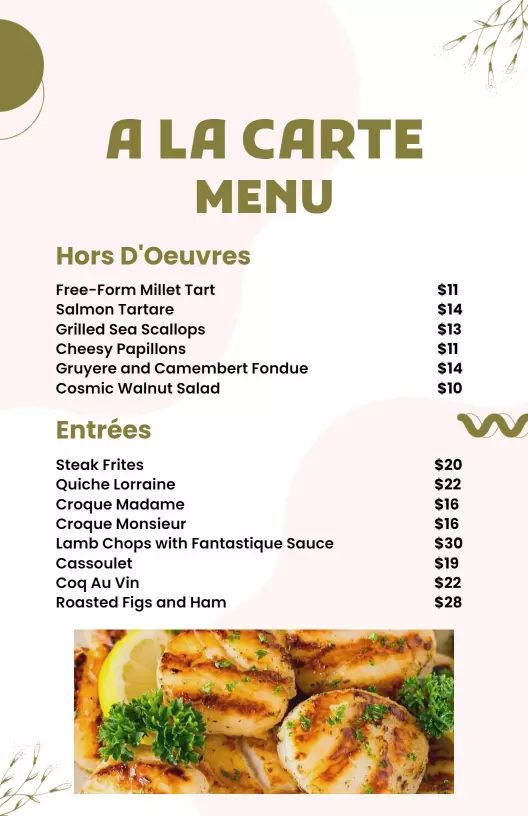
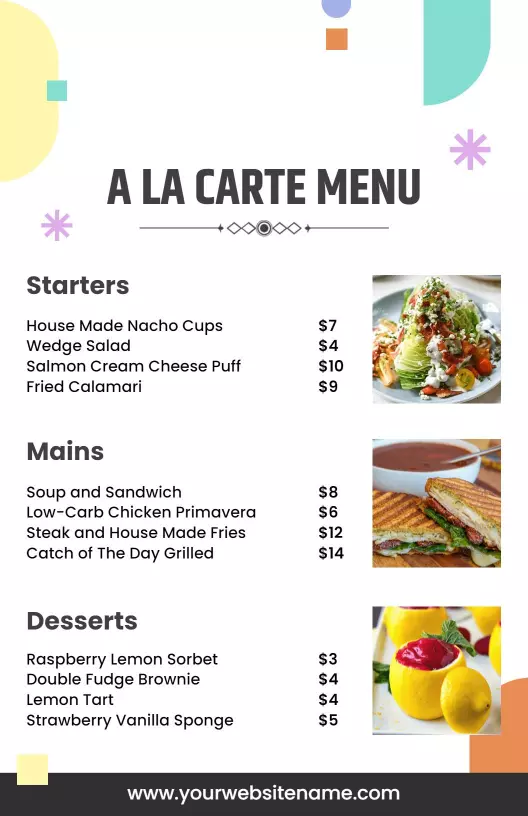
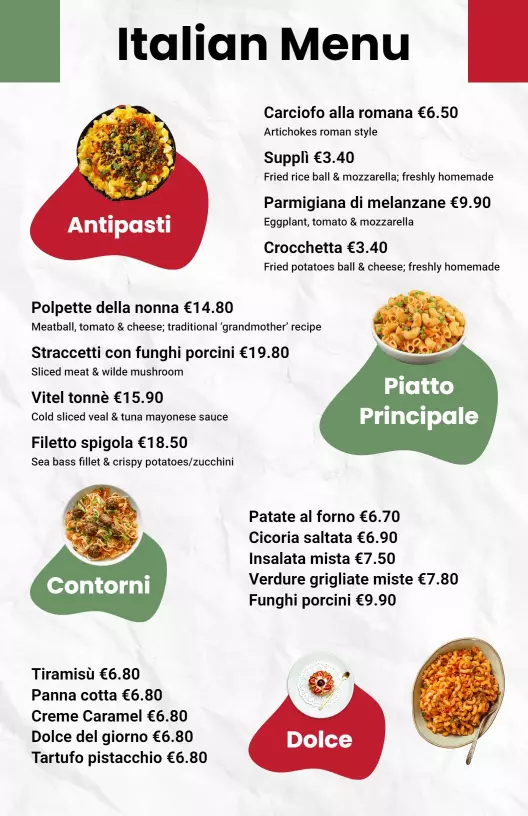
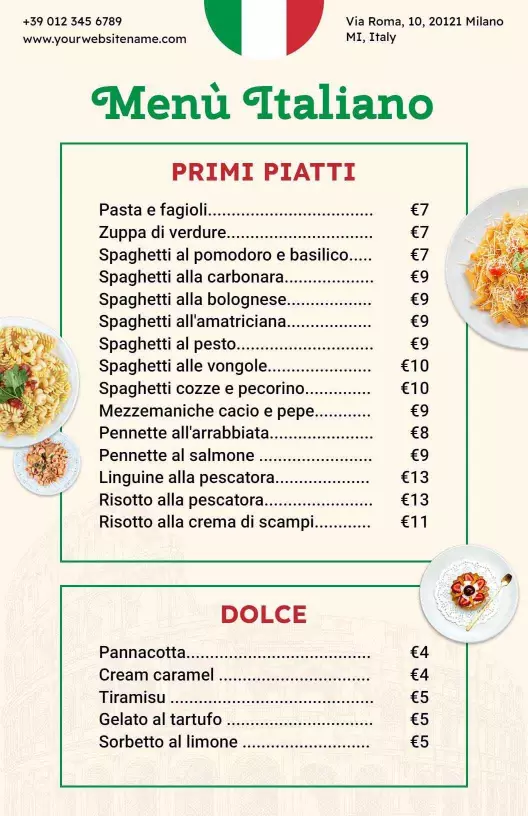
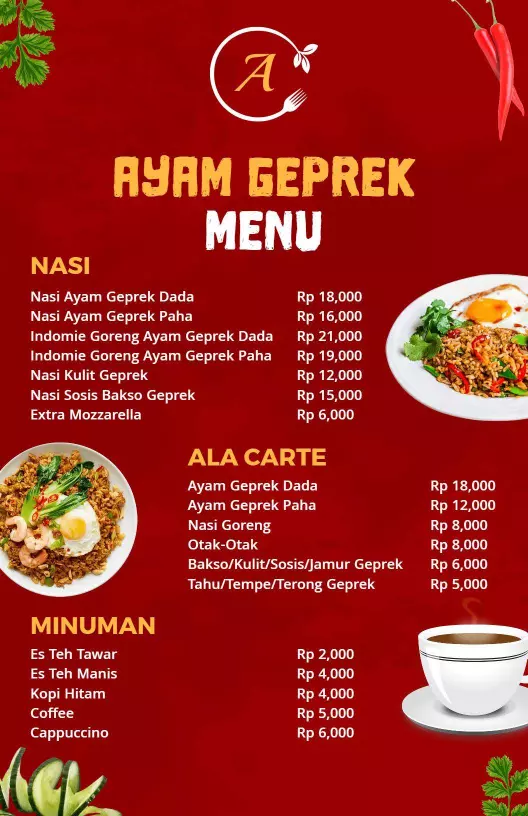
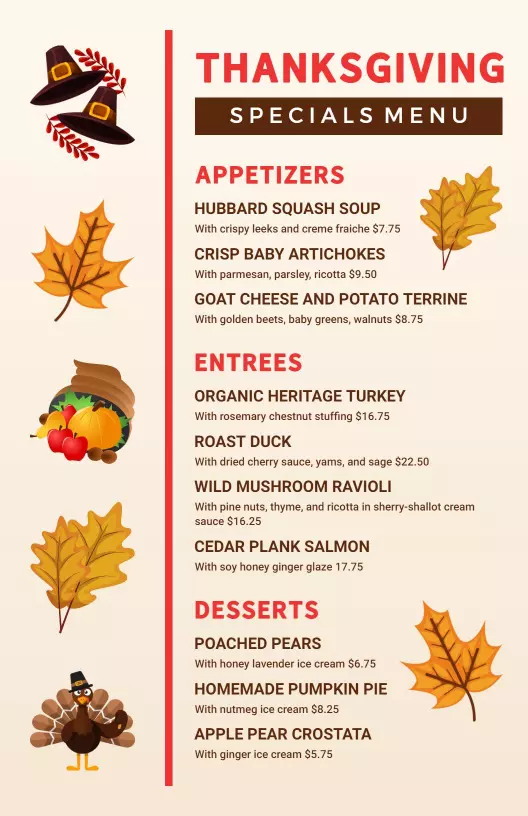
Note:- You can customize these printable menu templates easily to level up your a la carte menu design, even if you don’t have graphic design skills.
Why Do Restaurants Choose A La Carte Menus?
Restaurants often choose a la carte menus because they offer more flexibility and control for both customers and the restaurant itself. Unlike fixed-price menus or buffet-style dining, a la carte allows each dish to be ordered and priced separately.
Maximizing Revenue Potential
A la carte menus significantly increase average order values because customers often order multiple items. Instead of limiting themselves to preset combinations, diners can add appetizers, sides, desserts, and beverages individually. Therefore, restaurants see higher per-table revenue.
Accommodating Dietary Preferences
Modern diners have diverse dietary requirements and preferences. A la carte menus easily accommodate:
- Vegetarian and vegan customers
- Gluten-free dietary needs
- Portion size preferences
- Allergy-related restrictions
- Cultural dietary requirements
Reducing Food Waste
When customers order exactly what they want, restaurants experience less plate waste. Additionally, kitchens can better predict ingredient usage and adjust purchasing accordingly.
Better Profit Margins
Restaurants can price each item individually based on ingredient cost, preparation time, and popularity. This helps them:
- Charge more for premium ingredients (like truffle or steak)
- Adjust prices when food costs rise
- Promote high-margin dishes more easily
In this way, restaurants can maximize profits while still offering choice.
More Creative Freedom for Chefs
Chefs can design each dish as a standalone masterpiece rather than fitting it into a set menu. This:
Also, it encourages culinary creativity and allows seasonal or trending items to be added easily. Moreover, it helps in keeping the menu fresh and exciting
It keeps the restaurant’s food offerings innovative and competitive.
Enhancing Customer Satisfaction
Choice empowers customers and creates positive dining experiences. Furthermore, satisfied customers become repeat visitors and generate positive reviews.
How to Design an Effective A La Carte Menu?
Creating an effective a la carte menu is a smart way to offer flexibility and increase customer satisfaction. But simply listing dishes isn’t enough — the menu must be thoughtfully designed to reflect your brand, highlight popular dishes, and guide customer choices in a way that also boosts profitability.
1. Understand Your Audience First
Before writing a single dish name, think about your ideal customers. Are they casual diners, fine-dining guests, families, or tourists?
Understanding your audience helps you choose:
- The right dishes (e.g., comfort food vs. gourmet creations)
- The right portion sizes
- Appropriate pricing
If your guests expect value and variety, offer more choices with a range of price points. If they expect quality and uniqueness, keep the selection smaller but more curated.
2. Focus on Your Signature Dishes
Ensure that you’re highlighting your signature dishes first in the menu that defines your restaurant theme and brand.
You can add icons like a chef’s hat or a star, or put them in a special “House Favorites” section. It is the best way to appeal to your customers, and it will also provide a good starting point for your new menu style.
First impressions last. So, you should put your best foot forward with the menu items that speak for your restaurant as a whole.
3. Focus on Balance and Variety
An a la carte menu should offer enough variety to satisfy different tastes, but not so much that it overwhelms or confuses. Include a balance of:
- Proteins (chicken, beef, seafood, vegetarian)
- Cooking styles (grilled, baked, fried)
- Cuisines (if applicable – for example, global fusion, Italian, or modern Asian)
- Dietary options (gluten-free, vegan, low-carb)
This approach not only attracts a wider range of customers but also increases satisfaction.
4. Keep the Menu Manageable
Make sure that your menu is simple yet concise, especially if this is your first time offering this menu type.
Varieties are important, too many items can cause kitchen delays and increase inventory costs. Stick to a focused list that highlights your best offerings.
- Limit items in each category (e.g., 6–8 mains, 4–6 starters)
- Use ingredients that appear in multiple dishes to reduce waste
- Remove underperforming items regularly
A clean, compact menu with strong options is better than a lengthy one with too many weak or similar dishes.
5. Use Descriptive, Tasty Language
The way you describe your dishes matters. Great menu descriptions can make food sound more appealing and help guests understand the value of each item.
For example, instead of just writing “Grilled Chicken”, try:
“Charcoal-grilled chicken breast, marinated with lemon herbs, served with roasted vegetables.”
Tips for writing good menu descriptions:
- Mention key ingredients
- Include sensory words (crispy, creamy, slow-cooked)
- Avoid technical or confusing terms
- Keep it short and easy to read
This makes each dish more tempting and encourages guests to try something new or premium.
6. Include Dietary Labels and Allergen Info
Adding clear dietary labels and allergen information to your a la carte menu is essential for modern dining. Many guests today look for vegetarian, vegan, gluten-free, or nut-free options due to dietary preferences or medical reasons. Clearly marking these items with icons or brief notes helps customers make safe, confident choices without needing to ask.
Being transparent about dietary information not only improves the dining experience but also helps prevent health risks and potential liability for your business.
7. Create Menus in Multiple Languages
Creating an a la carte menu in multiple languages involves translating each menu item and description into various languages while ensuring cultural relevance.
The menu should be easy to navigate with a language-switching feature, so users can seamlessly choose their preferred language.
If you don’t know how to design multilingual menus, this guide will walk you through everything you need to know.
8. Consider Seasonal or Rotating Specials
Including seasonal or rotating specials in your a la carte menu adds freshness and excitement to your offerings. These specials allow you to highlight ingredients at their peak, offering better flavor and lower costs. Seasonal items also give regular customers something new to look forward to, encouraging repeat visits.
9. Make It Visually Appealing
Design plays a big role in how guests interact with your menu. A poorly designed menu can lead to confusion, poor sales, or a weak brand impression.
Tips for menu design:
- Use consistent fonts and clear headings
- Stick to a readable size (avoid text that’s too small)
- Add images only if they are high-quality and relevant
- Choose colors that match your restaurant theme
A clean, professional design improves trust and makes ordering easier.
What Are Common A La Carte Dishes?
1. Appetizers & Starters
These light, flavorful dishes are designed to stimulate the appetite before the main course. They’re often shared or enjoyed individually.
- Bruschetta – Toasted bread topped with diced tomatoes, basil, and olive oil
- Mozzarella Sticks – Breaded and fried cheese sticks served with marinara sauce
- Spring Rolls – Crisp vegetable or meat-filled rolls served with dipping sauces
- Chicken Wings – Spicy or BBQ wings served with blue cheese or ranch dip
2. Main Courses (Entrées)
Main dishes are the centerpiece of a la carte dining. Customers can pick exactly what they’re in the mood for, without needing to commit to a full-course meal.
- Grilled Salmon – Served with lemon butter or herb sauce
- Steak Frites – A classic combo of grilled steak and crispy fries
- Pasta Alfredo or Bolognese – Rich sauces over fettuccine or spaghetti
- Burgers – Beef, chicken, or veggie patties with customizable toppings
- Vegetarian Stir-Fry – Fresh vegetables sautéed in soy or teriyaki sauce
3. Side Dishes
These dishes complement the main course and can be mixed and matched to the guests’ liking.
- French Fries – Classic side for burgers or grilled meats
- Mashed Potatoes – Creamy and buttery, often served with steak or roast
- Steamed Vegetables – A Healthy choice for balancing a rich main
- Garlic Bread – A popular side for pasta dishes
4. Desserts
Sweet endings are a must for many diners and are always available separately on a la carte menus.
- Chocolate Lava Cake – Warm cake with molten chocolate center
- Cheesecake – Classic New York or fruit-topped versions
- Ice Cream or Sorbet – Single or multiple scoops with optional toppings
6. Beverages
Drinks are usually not included in meals and are ordered a la carte as well.
- Soft Drinks – Cola, lemon soda, etc.
- Fresh Juices – Orange, apple, watermelon
- Coffee/Tea – Often ordered after meals
- Mocktails and Cocktails – Seasonal or signature drinks
How Does A La Carte Menu Differ from Other Menu Types?
Understanding the distinction between a la carte and other restaurant menu types helps restaurant owners make informed decisions. Here’s how they compare:
A La Carte vs. Table d’Hôte:
- A la carte menus price each item individually
- Table d’hôte offers fixed-price complete meals
- Moreover, a la carte provides more flexibility
- Table d’hôte typically includes an appetizer, a main course, and a dessert
A La Carte vs. Prix Fixe:
- Prix fixe menus offer limited choices at set prices
- A la carte menus provide unlimited combinations
- Additionally, prix fixe simplifies kitchen operations
- A la carte maximizes customer choice and spending potential
And the Last, A La Carte vs. Buffet Style:
- Buffet dining offers unlimited quantities for one price
- A la carte ensures portion control and quality
- Furthermore, buffets reduce labor costs
- A la carte maintains food quality and presentation standards
What is the Difference Between A La Carte vs. Prix Fixe menu?
The main difference between an a la carte menu and a prix fixe menu lies in how the food is priced and ordered, as well as the flexibility each offers to the diner.
Here’s a detailed comparison of the two:
A la Carte Menu:
- Individual Pricing: Each item on the menu is priced separately. You pay for what you order, with no fixed price for the entire meal.
- Flexibility: You have complete control over what you choose. You can order just one dish, several appetizers, or mix and match from different categories (e.g., starters, mains, desserts).
- Customization: You can customize your meal by adding or removing items, and choosing how you want each dish prepared (e.g., how you like your steak cooked).
- Diverse Choices: There is often a wider selection of food items to choose from, as the restaurant may offer different kinds of appetizers, mains, sides, and desserts.
- Cost Control: The overall cost depends on what you choose. If you order many items, it can become expensive, but if you stick to a few dishes, it can be more affordable.
Prix Fixe Menu:
- Fixed Price: A prix fixe menu offers a set price for a complete meal, often consisting of multiple courses (e.g., appetizer, main course, dessert, and sometimes drinks).
- Limited Choices: While you may still get to choose from a few options within each course, the overall selection is more limited than with an à la carte menu. For example, you might have three choices for appetizers, three for mains, and two for desserts.
- Fixed Cost: The total cost is determined upfront, which can make it easier for customers to budget. Since the price is fixed, you don’t need to worry about the cost of each individual dish, and it can be a good value for those looking for a full dining experience.
- Structured Meal: The meal is typically pre-designed by the chef and follows a set flow of courses.
In conclusion of a la carte vs prix fixe menu, the a la carte menu is ideal for diners who want complete freedom and flexibility in selecting individual dishes, while the prix fixe menu is more structured and is perfect for those seeking a set dining experience at a fixed price.
What Design Elements Make A La Carte Menus More Effective?
An effective a la carte menu is not just about listing dishes and prices—it’s a communication tool that influences customer choices and enhances their dining experience.
Here are some key design elements that you must include in your menu.
1. Strategic Menu Categories
Effective a la carte menus organize items into logical categories:
Appetizers and Starters:
- Light bites to stimulate the appetite
- Shareable plates for groups
- Typically priced between $8 and-15
Main Courses:
- Protein-centered dishes
- Vegetarian and vegan options
- Price range varies by restaurant segment
Sides and Accompaniments:
- Vegetables, starches, and grains
- Usually priced between $4 to $8
- Essential for customization
Desserts:
- Sweet endings to meals
- Often overlooked profit centers
- Price point typically $6-12
Beverages:
- Alcoholic and non-alcoholic options
- Highest profit margins
- Critical for revenue enhancement
2. Clear Menu Layout and Structure
The foundation of a good menu is its layout. A clear structure helps guests scan and understand their options quickly. Sections should be organized in a logical flow, usually beginning with starters, followed by main courses, sides, desserts, and beverages.
Each category should be clearly labeled with bold headings and adequate spacing between sections.
3. Easy-to-Read Fonts and Consistent Color Scheme
Typography plays a key role in menu readability. Use fonts that are clean and easy to read, even in dim lighting. Script or decorative fonts may look stylish, but they can reduce legibility if overused. Stick to simple, modern typefaces for body text, and use a slightly bolder or larger font for section headers.
On the other hand, color plays an emotional and psychological role in menu design. Warm tones like red and orange can stimulate appetite, while cooler shades can create a calm and elegant vibe. The colors you use should match your restaurant’s branding, theme, and interior decor.
Learn more about typography and color scheme for menu design that attracts more customers.
4. Strategic Use of White Space
White space—the empty areas between menu elements—is crucial for clean design. It gives each dish room to “breathe” and keeps the menu from appearing cluttered. When used well, white space improves focus and makes the overall layout feel more upscale and relaxed.
Too much content packed into a single page can confuse diners.
5. Highlighting Signature or High-Profit Items
One of the main advantages of a la carte menus is the opportunity to promote specific dishes. Effective menu design makes it easier to draw attention to your most popular or profitable items.
You can highlight these dishes using subtle design elements like boxes, borders, or icons such as a star or chef’s hat. Using a different font color or background shade can also help signature items stand out.
6. Print Quality and Menu Material
The physical quality of your printed menu also affects how it’s perceived. A flimsy menu with smudged ink or stains sends the wrong message about your restaurant’s attention to detail. Use high-quality paper or laminated material for durability, especially in busy or outdoor settings.
Menus in fine-dining restaurants may be bound in leather or fabric for a premium feel, while cafés or bistros might use wood, recycled paper, or clipboards for a casual touch.
What Challenges Do A La Carte Menus Present?
Kitchen Complexity
Order Variability:
- Infinite combination possibilities
- Challenging inventory management
- Moreover, requires skilled kitchen staff
Preparation Time:
- Made-to-order items take longer
- Customer expectations for freshness
- Therefore, affects table turnover rates
Staff Training Requirements
Menu Knowledge:
- Servers need detailed product knowledge
- Ability to make recommendations
- Additionally, handle special requests confidently
Upselling Techniques:
- Training in suggestive selling
- Understanding profit margins
- Furthermore, building customer relationships
Technology Integration
POS System Compatibility:
- Handle complex orders efficiently
- Integrate with kitchen display systems
- Moreover, provide detailed reporting
Inventory Management:
- Track ingredient usage accurately
- Predict demand patterns
- Consequently, minimize waste and shortages
How Can Technology Enhance A La Carte Experiences?
Technology is changing the way customers experience a la carte dining, making it more personalized, efficient, and enjoyable.
1. Digital Menus with Real-Time Updates
Using digital screens or QR code menu style allows restaurants to update items instantly. Whether a dish is sold out or a new seasonal item is added, changes appear in real-time. This avoids customer disappointment and keeps the menu fresh.
2. Visual Appeal Through Interactive Menus
Modern digital menus can include photos, videos, or even animations of dishes. Showing the texture, size, and plating helps customers understand what they’re ordering, leading to more confident choices—and often, larger orders.
If you aren’t aware of the difference between a printed menu and a digital menu, reading this guide might clear your confusion.
3. Smart Recommendations and Personalization
Tech-driven menus can suggest dishes based on previous orders, dietary preferences, or pairing suggestions. For example, if a customer orders grilled chicken, the system might recommend a complementary side or sauce, just like online shopping platforms suggest related items.
4. Faster, Contactless Ordering
Customers can scan a QR code, browse the menu, place their order, and even pay—all from their smartphone. This not only improves hygiene but also reduces wait times and frees up staff to focus on service quality.
5. Data Insights for Better Menu Planning
Technology helps restaurants track which a la carte dishes are popular, when they sell best, and what combinations customers prefer. These insights can guide smarter pricing, portion control, and promotions.
What Common A La Carte Dishes to Add to Your Menu?
Here’s a list of common a la carte dishes you can consider adding to your menu. These items are usually ordered individually rather than as part of a set meal, giving customers the flexibility to mix and match their preferences:
| Main Course | Seafood | Appetizers & Salads | Vegetarian Options |
|---|---|---|---|
| Grilled Chicken Breast with Herb Butter | Grilled Salmon Fillet | Bruschetta | Grilled Vegetable Platter |
| Roasted Lamb Chops | Fish and Chips | Fried Calamari | Vegetable stir-fry |
| BBQ Pork Ribs | Seared Tuna Steak | Buffalo wings | Cauliflower steak |
| Duck Confit | Crab cakes | Shrimp cocktail | Spinach and ricotta cannelloni |
| Beef Tenderloin with Red Wine Sauce | Lobster Tail with Garlic Butter | French onion soup | Grilled portobello mushroom |
What Are the Future Trends in A La Carte Dining?
Sustainability Focus
Local Sourcing:
- Farm-to-table ingredients
- Seasonal menu variations
- Moreover, reduced environmental impact
Waste Reduction:
- Precise portion control
- Composting programs
- Therefore, appeal to environmentally conscious diners
Health-Conscious Options
Nutritional Transparency:
- Calorie counts and nutrition facts
- Ingredient sourcing information
- Additionally, dietary restriction accommodations
Customizable Healthiness:
- Preparation method choices
- Sauce and seasoning options
- Furthermore, portion size selections
Technology Integration
AI-Powered Recommendations:
- Personalized menu suggestions
- Predictive ordering systems
- Moreover, enhanced customer experiences
Automated Ordering:
- Voice-activated menu systems
- Contactless payment integration
- Consequently, streamlined operations
Frequently Asked Questions
1. What does “A La Carte” mean in restaurant terms?
A la carte means ordering individual menu items separately rather than choosing from preset meal combinations. Each dish has its own price, allowing customers to create customized meals. This French term literally translates to “from the card,” referring to ordering directly from the menu card.
2. How much should I charge for a la carte menu items?
Pricing depends on your restaurant type and location, but typically, restaurants use a 300-400% markup on food costs. Fine dining establishments often apply 400-500% markups. Consider your target market, competition, and positioning when setting prices. Factor in ingredient costs, labor, overhead, and desired profit margins.
3. What software is best for designing a la carte menu templates?
Lisi is an online menu creator and editor that offers professional-grade design control for print menus. It also provides user-friendly templates for various categories, perfect for beginners.
4. How can I optimize my a la carte menu for maximum sales?
Use menu engineering principles to highlight high-profit items. Apply psychological pricing strategies like charm pricing and anchoring. Create appealing descriptions with sensory language. Train staff in suggestive selling techniques.
5. Where are a la carte menus used?
A la carte menus are commonly used in restaurants, especially in places where customers want more flexibility and choice. These menus are popular in fine dining restaurants where people want to enjoy a personalized meal with a variety of options like appetizers, main courses, and desserts. You might also find a la carte menus in hotel restaurants, cafes, and bistros.
Conclusion
This was all about a la carte menu that offers more flexibility and freedom to customers to pick exactly what they want. This menu style is customer-friendly and perfect for creating a personalized dining experience. It allows guests to control their portions, try new dishes, and spend based on their budget.
For restaurants, a la carte menus help highlight high-margin items, reduce food waste, and keep the menu fresh with seasonal specials. With the right design, clear layout, and proper labeling, these menus can also improve sales and customer satisfaction.
As food trends evolve, the future of a la carte menus looks even more exciting. From plant-based options and digital ordering to personalized recommendations, restaurants can stay ahead by adapting to these changes.

